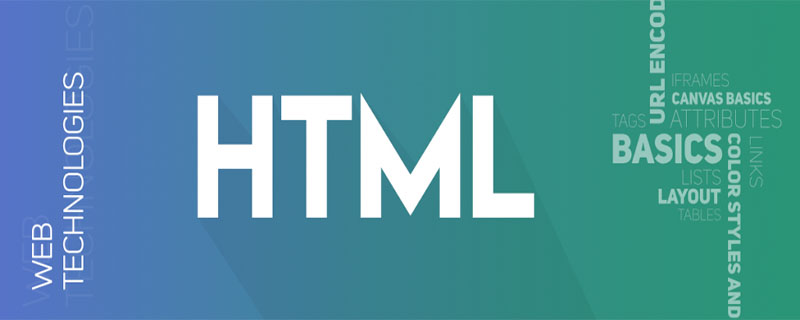The origin of HTML
The origin of HTML

##The full English name of HTML is Hypertext Marked Language, that is, Hypertext Marked Language Text markup language. HTML is a markup language created in 1990 by Tim Berners-Lee, the inventor of the Web, and his colleague Daniel W. Connolly. It is an application of the standard generalized markup language SGML. (Recommended learning: html tutorial)
Hypertext documents written in HTML are called HTML documents, which can be independent of various operating system platforms (such as UNIX, Windows, etc.) . Using HTML language, the information that needs to be expressed is written into HTML files according to certain rules, recognized by a dedicated browser, and these HTML files are "translated" into identifiable information, that is, the web page you see now. Since 1990, HTML has been used as the information representation language of the WWW. Files described in the HTML language need to be displayed through the WWW browser. HTML is a language for creating web page files. It displays images, sounds, pictures, text animations, movies and other content through markup instructions (Tag). In fact, every HTML document is a static web page file. This file contains HTML instruction codes. These instruction codes are not a programming language, but a way to layout the display position of information on the web page. Markup structure language, easy to learn and understand, very simple. The universal application of HTML is the technology that brought about hypertext - jumping from one topic to another, jumping from one page to another, and linking to files on hosts around the world with the click of a mouse. The Hypertext Transfer Protocol specifies the rules and operations that browsers follow when running HTML documents. The formulation of the HTTP protocol enables browsers to have unified rules and standards when running hypertext. A hypermedia document on the World Wide Web is called a page (foreign language: page). The page where an organization or individual places the starting point on the World Wide Web is called the homepage (foreign language: Homepage) or homepage. The homepage usually includes pointers (hyperlinks) to other related pages or other nodes, so-called A hyperlink is a Uniform Resource Locator (Uniform Resource Locator, foreign language abbreviation: URL) pointer. By activating (clicking) it, the browser can easily obtain a new web page. This is also one of the most important reasons why HTML is widely used. An organic collection of pages that is logically viewed as a whole is called a website (Website or Site). Hypertext Markup Language (English abbreviation: HTML) is a markup language designed for "web page creation and other information that can be seen in a web browser". The essence of a web page is HyperText Markup Language. By combining it with other Web technologies (such as scripting languages, public gateway interfaces, components, etc.), powerful web pages can be created. Therefore, Hypertext Markup Language is the basis of World Wide Web (Web) programming, which means that the World Wide Web is built on the basis of hypertext. Hypertext Markup Language is called Hypertext Markup Language because the text contains so-called "hyperlink" points.The above is the detailed content of The origin of HTML. For more information, please follow other related articles on the PHP Chinese website!

Hot AI Tools

Undresser.AI Undress
AI-powered app for creating realistic nude photos

AI Clothes Remover
Online AI tool for removing clothes from photos.

Undress AI Tool
Undress images for free

Clothoff.io
AI clothes remover

Video Face Swap
Swap faces in any video effortlessly with our completely free AI face swap tool!

Hot Article

Hot Tools

Notepad++7.3.1
Easy-to-use and free code editor

SublimeText3 Chinese version
Chinese version, very easy to use

Zend Studio 13.0.1
Powerful PHP integrated development environment

Dreamweaver CS6
Visual web development tools

SublimeText3 Mac version
God-level code editing software (SublimeText3)

Hot Topics
 1387
1387
 52
52
 Table Border in HTML
Sep 04, 2024 pm 04:49 PM
Table Border in HTML
Sep 04, 2024 pm 04:49 PM
Guide to Table Border in HTML. Here we discuss multiple ways for defining table-border with examples of the Table Border in HTML.
 HTML margin-left
Sep 04, 2024 pm 04:48 PM
HTML margin-left
Sep 04, 2024 pm 04:48 PM
Guide to HTML margin-left. Here we discuss a brief overview on HTML margin-left and its Examples along with its Code Implementation.
 Nested Table in HTML
Sep 04, 2024 pm 04:49 PM
Nested Table in HTML
Sep 04, 2024 pm 04:49 PM
This is a guide to Nested Table in HTML. Here we discuss how to create a table within the table along with the respective examples.
 HTML Table Layout
Sep 04, 2024 pm 04:54 PM
HTML Table Layout
Sep 04, 2024 pm 04:54 PM
Guide to HTML Table Layout. Here we discuss the Values of HTML Table Layout along with the examples and outputs n detail.
 HTML Input Placeholder
Sep 04, 2024 pm 04:54 PM
HTML Input Placeholder
Sep 04, 2024 pm 04:54 PM
Guide to HTML Input Placeholder. Here we discuss the Examples of HTML Input Placeholder along with the codes and outputs.
 Moving Text in HTML
Sep 04, 2024 pm 04:45 PM
Moving Text in HTML
Sep 04, 2024 pm 04:45 PM
Guide to Moving Text in HTML. Here we discuss an introduction, how marquee tag work with syntax and examples to implement.
 HTML Ordered List
Sep 04, 2024 pm 04:43 PM
HTML Ordered List
Sep 04, 2024 pm 04:43 PM
Guide to the HTML Ordered List. Here we also discuss introduction of HTML Ordered list and types along with their example respectively
 HTML onclick Button
Sep 04, 2024 pm 04:49 PM
HTML onclick Button
Sep 04, 2024 pm 04:49 PM
Guide to HTML onclick Button. Here we discuss their introduction, working, examples and onclick Event in various events respectively.




